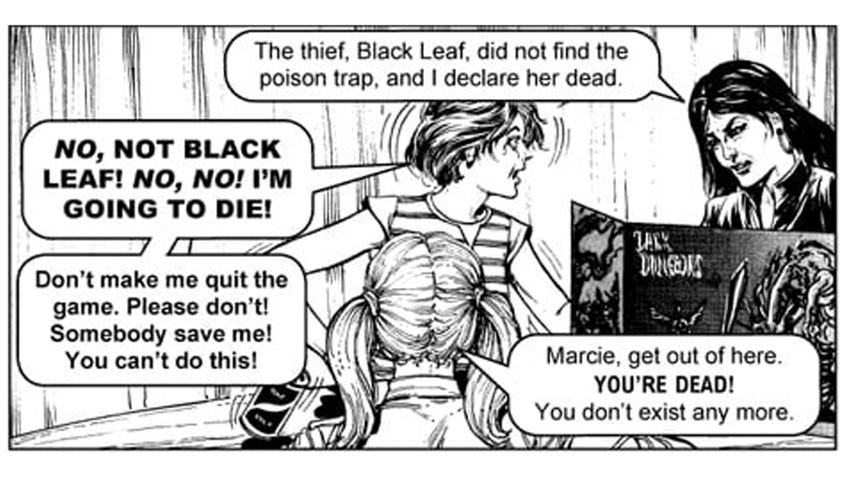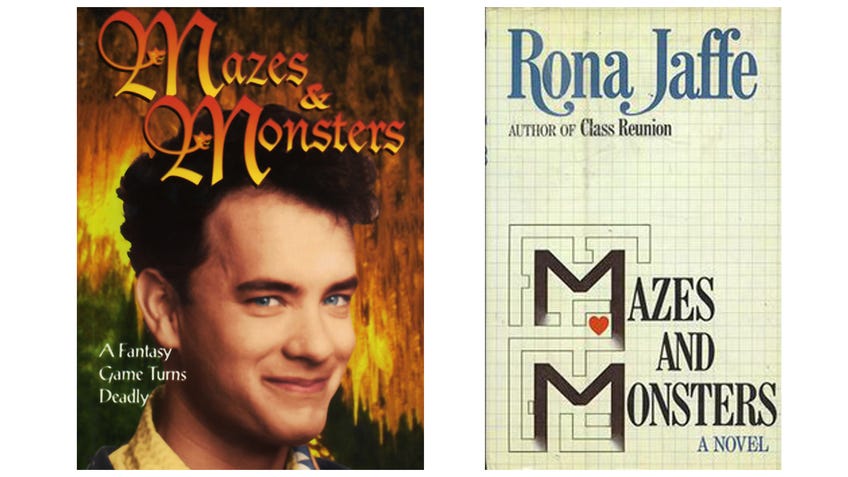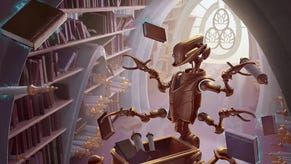How Dungeons & Dragons became a part of the 1980s Satanic Panic
Devils & Demons.
It’s very likely that you’ve heard about the Satanic Panic of the 1980s, a movement driven by the fear that ordinary people were being lured into devil-worshipping cults. However, you may not have known about its connection to one of the most popular tabletop roleplaying games in the world, Dungeons & Dragons.
The moral panic that gripped the US, and even parts of the UK, during the ’80s was sparked by more than just religious conviction and a lingering suspicion that can be traced all the way back to the Salem Witch Trials. The glamorisation of serial killers, the fear of your own neighbours and the eruption of conspiracy theories throughout the late ‘70s and early ‘80s are all integral to how the fantasy roleplaying game was painted as a nefarious gateway to the occult tainting the minds of young people.
Content warning for discussion of murder, suicide, depression and mentions of child abuse.
One of the most important things to remember when looking into the Satanic Panic of the 1980s is that it didn’t just appear out of nowhere. There were several instigators to the movement, namely the influx of apprehended serial killers and how the media reported the news to the general public.
In 1969 a string of violent crimes committed were tied to The Manson Family. The ‘family’ was a cult lead by their purportedly charismatic leader Charles Manson, an American ‘musician’ who led a California based group responsible for the murders of nine people from between July and August 1969. One of the most reported murders being that of actress Sharon Tate and the four guests in her home.
Without going into depth, a lot of the imagery left behind led the American public to believe that the killings were ritualistic in nature. This set the scene for a disrupted America that wasn’t able to see itself as wholesome anymore. Gone was the idea that the innocent were safe and secure. With the killing of Tate, who also unfortunately happened to be pregnant at the time, North America fell into a dark spiral of paranoia.
When the 1970s arrived, so did a slew of new serial killers who were infamous for either blending into the shadows or blending in amongst a crowd. Also tailing off the ‘60s was the activity of the still unidentified serial killer known as The Zodiac Killer. With the murderer remaining on the run and sending out coded messages to media outlets with a signature symbol, it’s no wonder a lot of people at the time were suspicious of writings and iconography they didn’t understand.
It's a misunderstanding that there was an influx of serial killers over the 1960s and ‘70s. Rather, there was a rise in simply a rise in coverage.
Another key killer of the ‘70s was Ted Bundy, who used his charm and good looks to lure women to their demise. His techniques were also useful for fooling the general public into thinking he was harmless and falsely accused. Which only made it all the more horrifying when what he had done was revealed, with crimes so ghastly that they prompted one of his own legal team, Polly Nelson, to write that he was the “...very definition of heartless evil.” Bundy also managed to escape police custody several times whilst on trial, which resulted in even more murders and the public being completely floored by the seemingly newfound level of danger this presented.
Of course, there were plenty of other killers plaguing America at the time. Others include John Wayne Gacy, Son of Sam and even over in the UK there was The Yorkshire Ripper. The ‘70s were rife with them. However, it is a misunderstanding that there was an influx of serial killers over the 1960s and ‘70s. Rather, there was a rise in simply a rise in coverage, because the press just love a scary serial killer.

An excellent example of how the press glorified killers during the ‘60s and ‘70s is the fact that Ted Bundy’s trial was the first one to ever be televised. The trail launched Bundy into celebrity status, further heightening his already overinflated sense of ego. When we look back at the killers and cult leaders already mentioned, they have been both interviewed and televised – as well as go out of their way to notify media outlets of their heinous deeds. This has never been for the benefit of the police’s attempts to apprehend them, it’s always been to get them the recognition they crave.
The media was really coming into its own in the 1970s and many outlets were starting to learn that killer stories got them good numbers, even going so far as revealing information that the public were not supposed to know about.
The impact of both the book and film of The Exorcist in 1971 and 1973 respectfully, cannot be understated.
However, it wasn’t only the press who were exacerbating this issue. In 1969, the same year as the Manson Family killings, The Satanic Bible by Anton LaVey was published. Though the book was heavily derived from other sources, it became a very important work for The Church of Satan. Though the Church of Satan was established by LaVey himself in 1966, the existence of an official ‘biblical’ text tied to Satanism changed things.
The impact of both the book and film of The Exorcist in 1971 and 1973 respectfully, cannot be understated. Many associate William Peter Blatty’s extremely successful novel with the fact that a portion of the public believed that demons were, in fact, real, all because the film warned audiences that it was based on a true story. This, frankly, fantastic marketing tactic coupled with audience members crying and fainting whilst watching the film version, resulted in enormous success for The Exorcist. However, it also pushed America further and further over the edge of paranoia.
One of the most infamous instances of people making accusations of satanic rituals was a memoir titled Michelle Remembers published in 1980. The premise of the book was that co-author Lawrence Pazder was a psychologist purported to be uncovering the repressed memories of his wife Michelle Smith via hypnosis. Though the memoir was debunked almost as soon as it was released. Nevertheless, thanks to the press, the book became a wide-spread phenomenon, leading to Pazder being seen as an expert on the subject.
Many directly tie Michelle Remembers and its popularity to the instigation of the phenomena of Daycare Panic. Soon afterwards, people became obsessed with the idea that several Daycares in the US were a front for satanic rituals that were harming children. Ken Lanning who formerly worked for the FBI said, “The evidence wasn’t there, but the allegations of satanic ritual abuse never really went away…When people get emotionally involved in an issue, common sense and reason go out the window. People believe what they want and need to believe.”
The claims were never founded on evidence and the accusations included people turning into witches and flying, flushing children down toilets.
Several pre-schools were accused of misconduct throughout the 1980s including, and most disastrously, McMartin Daycare in Manhattan Beach, California. To date, the trial against McMartin is the most expensive in Californian history, only to have all charges dropped against the defendants in 1990. These claims were never founded on evidence and the accusations were sweeping and wild, they included people turning into witches and flying, flushing children down toilets and secret underground tunnels where rituals were carried out. In fact, many people took things into their own hands and tried digging around the Daycare to uncover these tunnels!
Though the investigations in the 80s were not backed up by hard evidence they ended up sending at least 26 people to jail and one man served 20 years of a 40-year sentence that was eventually overturned.

At the time, the public were being told by many authority figures that the accusations were real. Anna Merlan, author of Republic of Lies: American Conspiracy Theorists and their Surprising Rise to Power, said, “very credible-seeming people were saying: ‘Occult ritual abuse is all around you. We’ve seen it and the signs are visible if you know how to look for it.’”
The combination of fear mongering, stranger danger and more were all factors in the persecution of the now wildly popular Dungeons & Dragons roleplaying game.
In 1979, 16-year-old James Dallas Egbert III was discovered to be missing from his dorm at Michigan State University. The private investigator hired by his parents believed that not only was it due to foul play, but it was also due to his history of playing D&D.
Author Rona Jaffe wrote a book called Mazes and Monsters based on what happened to Egbert, which was later turned into a film starring a young Tom Hanks.
Unfortunately, Egbert was suffering from mental health issues and drug addiction that resulted in him taking refuge in the utility tunnels underneath the school. He ultimately took his own life in 1980 and many still believed that the cause of his untimely death was D&D. A lot of people used this hype to market themselves and their work. For example, author Rona Jaffe wrote a book called Mazes and Monsters based on what happened to Egbert, which was later turned into a film starring a young Tom Hanks. The detective hired to look for him, William Dear, also played on the D&D angle of the case to launch himself into the limelight, writing his own book on the subject in 1984. TSR, the then publishers of D&D, even saw a rise in sales following the release of Egbert’s story.

However, the first real campaign against D&D started with Patricia Pulling. Irving Lee Pulling was a high school student who had trouble fitting in at school and eventually took his own life. His mother, Patricia Pulling, was convinced that her son’s death was caused by Dungeons & Dragons. In pursuit of closure, Patricia tried to sue TSR and her son’s principal - who had placed a curse upon his player character that she believed to be real. She put together a campaign called BADD (Bothered About Dungeons and Dragons) after her claims were dismissed by the court. Among other things, Pulling and BADD described D&D as “a fantasy roleplaying game which uses demonology, witchcraft, murder, satanic type rituals, demon summoning.”
BADD was put together a media campaign against D&D through conservative Christian outlets and even appeared on 60 Minutes - a mainstream television show - to discuss their views with Gary Gygax, one of D&D’s original creators. Author Michael Stackpole published The Pulling Report, listing the numerous errors made by BADD and Pulling, calling the protestor out for her lack of legitimate credentials, despite having represented herself as an ‘expert witness on games’.
A lot of the concerns over D&D were focused on the idea that it was able to influence young people, leaving them unable to discern fantasy from reality.
TSR even went so far as to hire a psychologist, Joyce Brothers, who defended Dungeons and Dragons to the public, letting people know that the whole point of D&D was that good was meant to triumph over evil.
A lot of the concerns over D&D were focused on the idea that it was able to influence young people, leaving them unable to discern fantasy from reality. Religious figures likened Dungeons & Dragons to demon worship, due to the inclusion of gods in the game. It was even said that if your character died in the game then the player could be driven to suicide, which was likely born from rumours around Egbert and Irving Lee Pulling’s passing.
D&D’s growing popularity meant that a lot of kids were playing it and, separately, some of those kids happened to be involved in tragedy.
Mary Towey was murdered by two boys in 1984 who also happened to play D&D - Ron Adcox and Darren Molitor. Molitor even tried to blame D&D for his actions, complaining that he should have been allowed to include the RPG as part of his defence following his conviction. He claimed that D&D had taught him to play mind games that he planned to use on Mary Towey. Molitor also claimed that playing Dungeons & Dragons would accustom him to violence and lure him away from God.
In 1988, Dungeons & Dragons player Chris Pritchard conspired to murder his stepfather and his mother over inheritance money. Though his mother survived the attack, his stepfather Leith Von Stein was killed. Pritchard’s fellow D&D party members, James Bartlett Upchurch III and Gerald Neal Henderson, were convicted of aiding and abetting the murder.
Moral panic surrounding D&D may have been rife in the 1980s, but it doesn’t mean it’s completely unheard of now. In 2004, inmates at Waupun Correctional Facility in Wisconsin had their books and character sheets taken from them because officials feared that D&D promoted gang violence. However, nowadays Dungeons & Dragons is used as a tool for promoting teamwork and social skills in schools.
If you ever experience depression or issues with mental health - regardless of whether you play Dungeons & Dragons or not - then doctors, counsellors, organisations, friends and family are all there to help. There is a list of numbers included at the bottome of this artcile that you can call if you need someone to talk to.
- SANEline. If you're experiencing a mental health problem or supporting someone else, you can call SANEline on 0300 304 7000 (4.30pm–10.30pm every day).
- National Suicide Prevention Helpline UK. Offers a supportive listening service to anyone with thoughts of suicide. You can call the National Suicide Prevention Helpline UK on 0800 689 5652 (open 24/7).
- The Mix. If you're under 25, you can call The Mix on 0808 808 4994 (3pm–midnight every day), request support by email using this form on The Mix website or use their crisis text messenger service.










